It looks like you're using an Ad Blocker.
Please white-list or disable AboveTopSecret.com in your ad-blocking tool.
Thank you.
Some features of ATS will be disabled while you continue to use an ad-blocker.
19
share:
Earth and the Red Planet align favorably for interplanetary travel just once every 26 months, for a few weeks at a time. The next such window opens in mid-July 2020, and four big-ticket missions aim to take full advantage.
4 Mars Missions Are One Year Away from Launching to the Red Planet in July 2020
2020 United Arab Emirates - Hope Mars Mission

The Hope Mars Mission (Arabic: مسبار الأمل) also called Emirates Mars Mission, is a space exploration probe mission to Mars funded by the United Arab Emirates and set for launch in 2020. Upon launch, it will become the first mission to Mars by any Arab or Muslim majority country. The probe will study the climate daily and through seasonal cycles, the weather events in the lower atmosphere such as dust storms, as well as the weather on Mars different geographic areas. The probe will attempt to answer the scientific community questions of why Mars atmosphere is losing hydrogen and oxygen into space and the reason behind Mars drastic climate changes.
The mission is being carried out by a team of Emirati engineers in collaboration with foreign research institutions, and is a contribution towards a knowledge-based economy in the UAE. The probe has been named Hope or Al-Amal (Arabic: اللأمل) and it is scheduled to reach Mars in 2021, which coincides with the 50th anniversary of the United Arab Emirates' formation.
2020 China - Mars Global Remote Sensing Orbiter and Small Rover (HX-1)
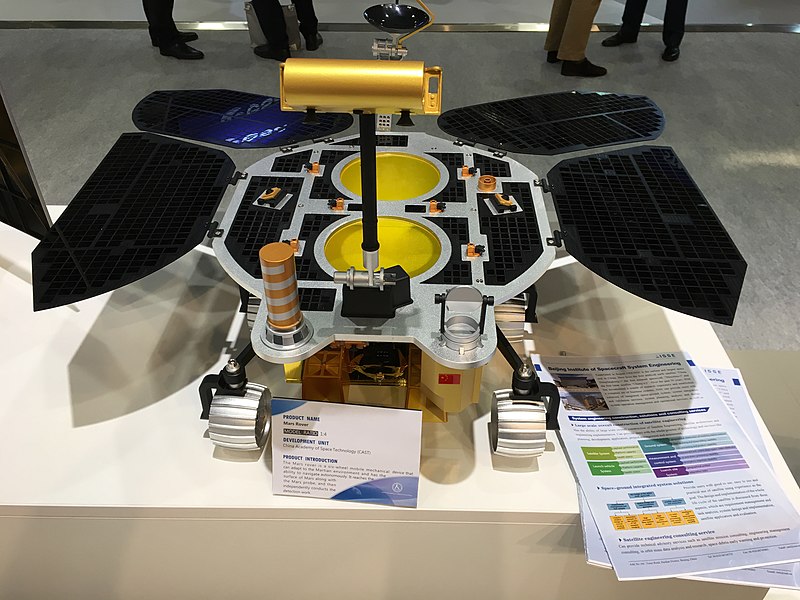
The rover will be powered by solar panels, probe the ground with radar, perform chemical analyses on the soil, and look for biomolecules and biosignatures.
The priorities of the mission include finding both current and previous life, and evaluating the planet's surface and environment. Solo and joint explorations of the Mars orbiter and rover will produce maps of the Martian surface topography, soil characteristics, material composition, water ice, atmosphere, ionosphere field, and other scientific data will be collected. Simulated landings have been performed for the mission preparations by the Beijing Institute of Space Mechanics and Electricity.
This Mars mission would be a demonstration of technology needed for a Mars sample return mission proposed for the 2030s. Another plan involves the 2020 HX-1 mission to cache samples for retrieval in 2030.
2020 European-Russian - Rosalind Franklin Rover
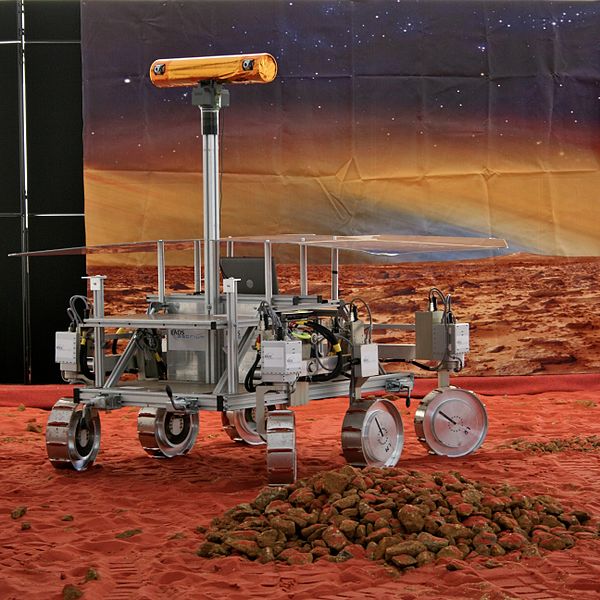
Rosalind Franklin, previously known as the ExoMars rover, is a planned robotic Mars rover, part of the international ExoMars programme led by the European Space Agency and the Russian Roscosmos State Corporation.
Scheduled to launch in July 2020, the plan calls for a Russian launch vehicle, an ESA carrier module, and a Russian lander named Kazachok, that will deploy the rover to Mars' surface. Once safely landed, the solar powered rover would begin a seven-month (218-sol) mission to search for the existence of past life on Mars. The Trace Gas Orbiter (TGO), launched in 2016, will operate as Rosalind Franklin's and lander's data-relay satellite.
The rover is named after English chemist and DNA pioneer, Rosalind Franklin.
2020 USA - Mars 2020 rover
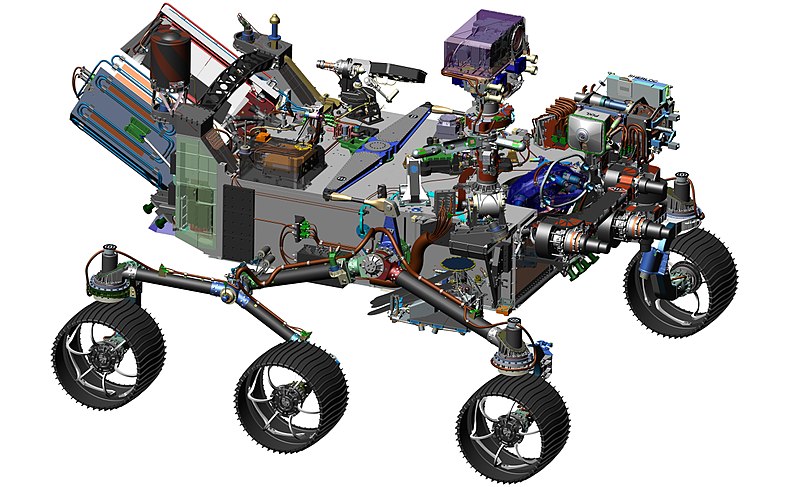
Mars 2020 is a Mars rover mission by NASA's Mars Exploration Program with a planned launch on 17 July 2020, and touch down in Jezero crater on Mars on 18 February 2021. It will investigate an astrobiologically relevant ancient environment on Mars and investigate its surface geological processes and history, including the assessment of its past habitability, the possibility of past life on Mars, and the potential for preservation of biosignatures within accessible geological materials. It will cache sample containers along its route for a potential future Mars sample-return mission.
It will be historic if all these craft make it to Mars.
I think NASA may share the info needed with the ESA to land safely on Mars. Lets hope the Russian rocket can do it's job without a mishap.
China may have figured out the needed info to land safely (or hacked it). With their success on the moon landings, I would give them a 50/50 chance of landing safely on Mars.
UAE is only going for a Mars orbit insert. The odds are still against them, unless NASA has shared there too.
We will see, I hope they all make it.
ESA and NASA then plan to work together to complete a Mars sample return.
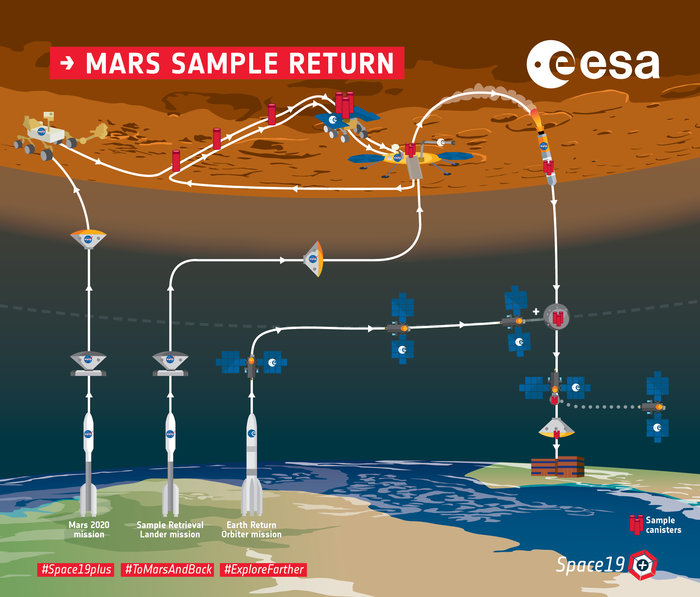
A NASA launch will send the Sample Return Lander mission to land a platform near the Mars 2020 site. From here, a small ESA rover – the Sample Fetch Rover – will head out to retrieve the cached samples.
Once it has collected them in what can be likened to an interplanetary treasure hunt, it will return to the lander platform and load them into a single large canister on the Mars Ascent Vehicle (MAV). This vehicle will perform the first liftoff from Mars and carry the container into Mars orbit.
Mars Sample Return - ESA
Esa and the American space agency (Nasa) expect to send the sample-return equipment to the Red Planet in 2026.
"It will be a relatively small rover – about 130kg; but the requirements are very demanding," said Ben Boyes who will lead the feasibility team at Airbus.
"The vehicle will have to cover large distances using a high degree of autonomy, planning its own path ahead day after day," he told BBC News.
Esa and Nasa signed a letter of intent in April committing themselves to bringing back pieces of Martian rock and soil to Earth before the end of the next decade.
Fetch rover! Robot to retrieve Mars rocks
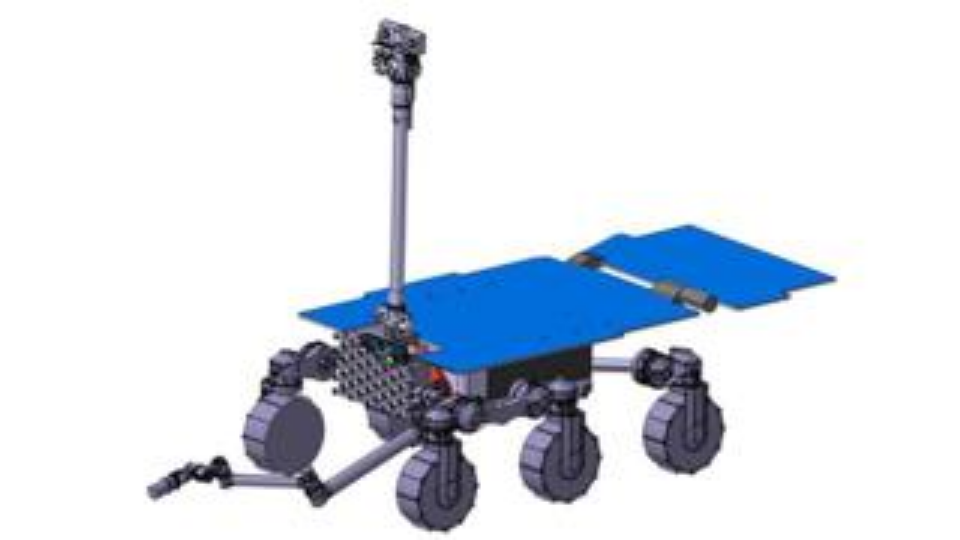
a reply to: LookingAtMars
Very cool. Seems a bit unnecessary though to send a rover to collect the canisters. They should just make the rover that create the canisters to keep them on board until it gets to the rendezvous point. I hope that one succeeds. Could be the basis of a great sci-fi movie - Mars sample contains bacteria or dormant seed that, once on Earth, comes to life and threatens all of humanity!
Very cool. Seems a bit unnecessary though to send a rover to collect the canisters. They should just make the rover that create the canisters to keep them on board until it gets to the rendezvous point. I hope that one succeeds. Could be the basis of a great sci-fi movie - Mars sample contains bacteria or dormant seed that, once on Earth, comes to life and threatens all of humanity!
these are cool rovers and i'm sure they'll do valuable scientific work. but i'm looking forward to manned missions to mars, hopefully in the not too
distant future. something the world can get behind.
a reply to: LogicalGraphitti
I think the best idea would be for the sample to be returned to the ISS for testing. If everyone on the ISS survives and are not turned into alien creatures, then return it to Earth.
Could be the basis of a great sci-fi movie - Mars sample contains bacteria or dormant seed that, once on Earth, comes to life and threatens all of humanity!
I think the best idea would be for the sample to be returned to the ISS for testing. If everyone on the ISS survives and are not turned into alien creatures, then return it to Earth.
a reply to: LookingAtMars
This type of stuff pushes tech innovation just as hard as war does. But is a much better way to do it.
I'm excited by the tech advancements that will come from this.
This type of stuff pushes tech innovation just as hard as war does. But is a much better way to do it.
I'm excited by the tech advancements that will come from this.
a reply to: LookingAtMars
It's hard to image anything being alive on Mars.
The thin atmosphere lets in loads of solar radiation so anything living would be a tough son of a gun.
That and the chances of a life form being biologically compatible with humans is very slim.
Best to error on the side of caution though.
It's hard to image anything being alive on Mars.
The thin atmosphere lets in loads of solar radiation so anything living would be a tough son of a gun.
That and the chances of a life form being biologically compatible with humans is very slim.
Best to error on the side of caution though.
originally posted by: Bluntone22
a reply to: LogicalGraphitti
The andromeda strain...
Older movie not the newer one...
A great movie and a great book by Michael Crichton. I remember when it came out.
originally posted by: RoScoLaz5
these are cool rovers and i'm sure they'll do valuable scientific work. but i'm looking forward to manned missions to mars, hopefully in the not too distant future. something the world can get behind.
Maybe some day there will be people on Mars but I doubt it'll happen in my lifetime.
I didn't know the US was the only country to land and operate a rover on Mars. The track record for other countries is 100% failure.
A "g" says that chineese rover will run like a Honda Civic in a snowbank when those micro-machine wheels hit the sand.
originally posted by: RoScoLaz5
these are cool rovers and i'm sure they'll do valuable scientific work. but i'm looking forward to manned missions to mars, hopefully in the not too distant future. something the world can get behind.
I agree with this completely! It's basically what I came here to say. Maybe in 2026 or 2032?
I'm surprised to see no planned rovers from the African Space Agency (ASA).
Oh...wait...
But seriously, jokes aside, it's good to see that Mars is still in the sights (of the human community).
A manned mission or two is planned for the late twenties, early thirties. The logistics and planning is still quite daunting (even for SpaceX), but humanity hopes to launch *at least* one manned mission to "The Red Planet" within the next decade...
Oh...wait...
But seriously, jokes aside, it's good to see that Mars is still in the sights (of the human community).
A manned mission or two is planned for the late twenties, early thirties. The logistics and planning is still quite daunting (even for SpaceX), but humanity hopes to launch *at least* one manned mission to "The Red Planet" within the next decade...
edit on 29-7-2019 by AnakinWayneII because: (no reason given)
a reply to: LookingAtMars
Fabulous news..
But with this much rovers up there we are going to need a parking lot next.
Peace
Fabulous news..
But with this much rovers up there we are going to need a parking lot next.
Peace
Humanity is colonizing Mars right now, if you can define a human as having 6 wheels, solar panels and/or nuclear power, and no need to perform actual
sentient thought.
Come on space people, get it together. We need boots on the ground, with HUMANS in them.
End of story.
If we do not get humans there, why go?
Come on space people, get it together. We need boots on the ground, with HUMANS in them.
End of story.
If we do not get humans there, why go?
edit on 29-7-2019 by Archivalist because: meh
originally posted by: Archivalist
Humanity is colonizing Mars right now, if you can define a human as having 6 wheels, solar panels and/or nuclear power, and no need to perform actual sentient thought.
Come on space people, get it together. We need boots on the ground, with HUMANS in them.
End of story.
If we do not get humans there, why go?
It's gonna take several decades before we even get anywhere close to even beginning to "colonise" Mars.
The logistics and variables and planning is very, very daunting. Even chucking tens of billions of dollars at it will not make the situation any better.
Even more so, the long-term feasibility of manned outposts and bases on Mars is questionable at best (even medium-term is shaky). Even building such bases and outposts underground would be challenging.
This isn't a Hollywood movie, it's real life. Practicality and pragmatism is key here.
EDIT: Do not mistake my practicality and pragmatism with pessimism. I did not say that "we can't"; I simply underlined the challenging aspects of manned Mars missions (which include, but is by no means limited to, impact events, survival, numbers, mission duration, radiation concerns, supplies, renewability, longevity etc etc)
edit on 29-7-2019 by AnakinWayneII because: (no reason given)
a reply to: AnakinWayneII
More time is necessary, is a thought.
My thought, there is not enough time to wait.
Just send us there in a box of minimalism, with no return if necessary.
Someone would surely agree to such a feat.
We sent men to their death, in plywood gliders on D-Day.
Pilots, literally made to fly boxes of wood over the front lines of nazi soldiers. (Wooden gliders were thrown, without engines, behind enemy lines, with pilots of most convenience.)
If we will drop men in wooden boxes, to fight men capable of shooting boxes in half, why worry of the feats of space?
We saved Tom Hanks and some other guys with some duct tape and socks, in the middle of a vast space trip, before the dawn of the TI-83 calculator.
We can do it.
More time is necessary, is a thought.
My thought, there is not enough time to wait.
Just send us there in a box of minimalism, with no return if necessary.
Someone would surely agree to such a feat.
We sent men to their death, in plywood gliders on D-Day.
Pilots, literally made to fly boxes of wood over the front lines of nazi soldiers. (Wooden gliders were thrown, without engines, behind enemy lines, with pilots of most convenience.)
If we will drop men in wooden boxes, to fight men capable of shooting boxes in half, why worry of the feats of space?
We saved Tom Hanks and some other guys with some duct tape and socks, in the middle of a vast space trip, before the dawn of the TI-83 calculator.
We can do it.
new topics
-
Joe Rogan conspiracy (maybe)
ATS Skunk Works: 36 minutes ago -
Results of the use of the Oreshnik missile system in Dnepropetrovsk
World War Three: 2 hours ago -
Nigel Farage now the Most Favoured UK Politician
Regional Politics: 4 hours ago -
Little Johnny and Larry should team up
General Chit Chat: 10 hours ago -
Will Us use alien technology to fight in ww3?
World War Three: 11 hours ago
top topics
-
Results of the use of the Oreshnik missile system in Dnepropetrovsk
World War Three: 2 hours ago, 10 flags -
Little Johnny and Larry should team up
General Chit Chat: 10 hours ago, 8 flags -
Shane Gillis commercial
Jokes, Puns, & Pranks: 17 hours ago, 4 flags -
Will Us use alien technology to fight in ww3?
World War Three: 11 hours ago, 2 flags -
Nigel Farage now the Most Favoured UK Politician
Regional Politics: 4 hours ago, 2 flags -
Joe Rogan conspiracy (maybe)
ATS Skunk Works: 36 minutes ago, 0 flags
active topics
-
Results of the use of the Oreshnik missile system in Dnepropetrovsk
World War Three • 74 • : Oldcarpy2 -
Well we know Putins ICBMs won't fail in their silos
World War Three • 189 • : Lazy88 -
President-Elect TRUMP Picks Former Florida A.G. PAM BONDI to be U.S. Attorney General.
2024 Elections • 50 • : Xtrozero -
President-Elect DONALD TRUMP's 2nd-Term Administration Takes Shape.
Political Ideology • 238 • : WeMustCare -
Will Us use alien technology to fight in ww3?
World War Three • 11 • : BeyondKnowledge3 -
A Mysterious Orb filmed over NYC by local news
Aliens and UFOs • 25 • : ArMaP -
The Popular Vote does not matter
Political Issues • 14 • : texas thinker -
Joe Rogan conspiracy (maybe)
ATS Skunk Works • 0 • : AlroyFarms -
Shane Gillis commercial
Jokes, Puns, & Pranks • 2 • : Flyingclaydisk -
Little Johnny and Larry should team up
General Chit Chat • 2 • : texas thinker
19
